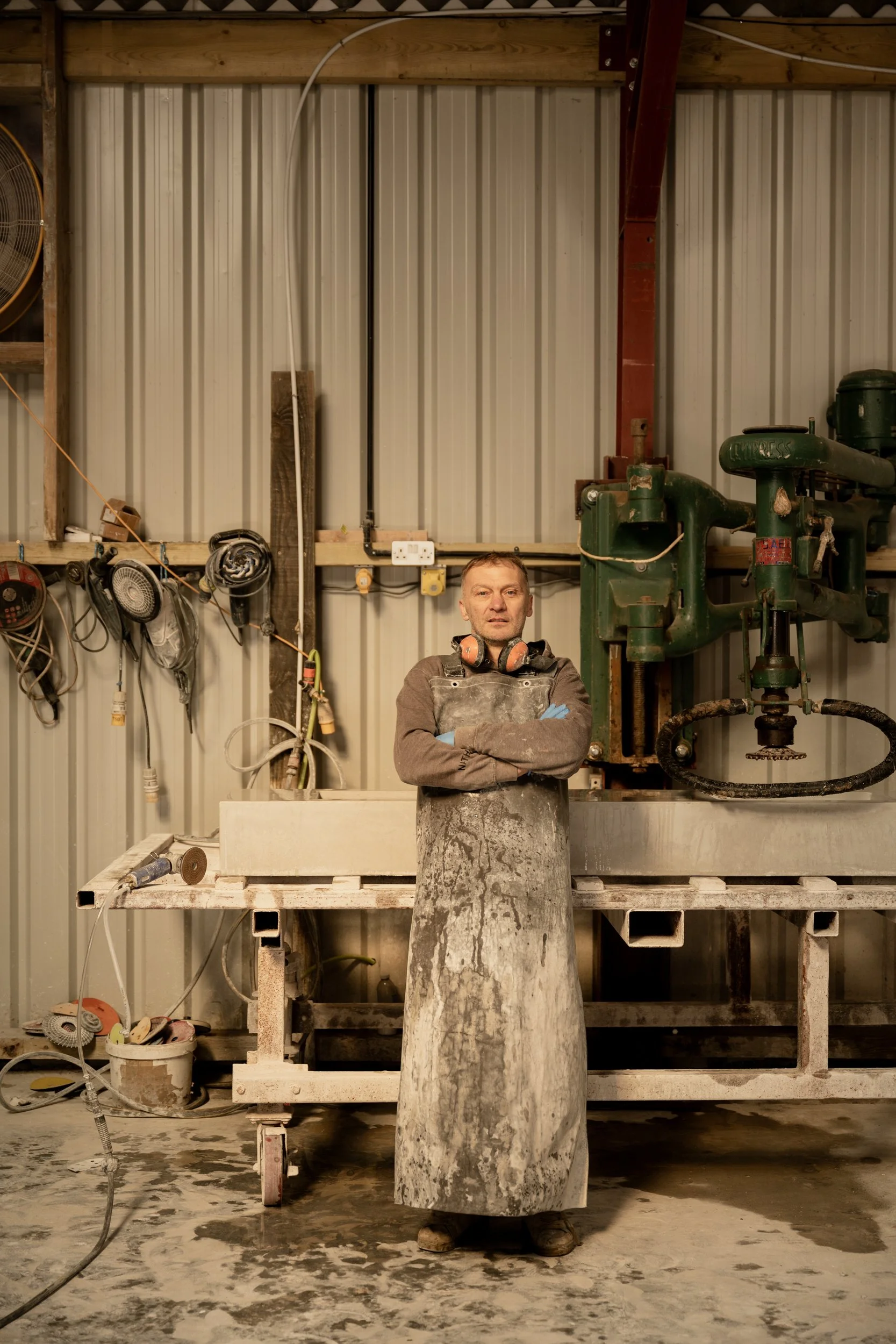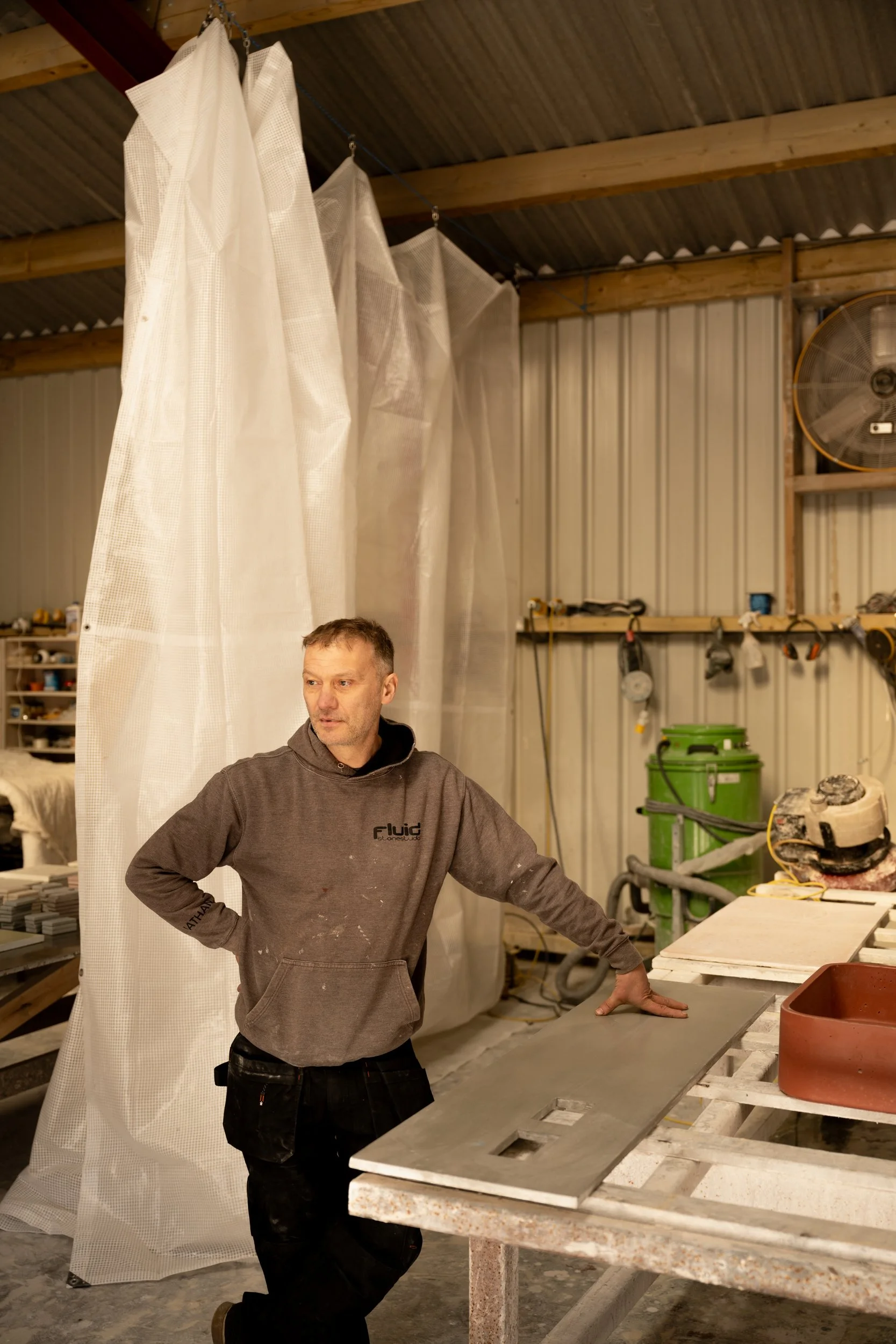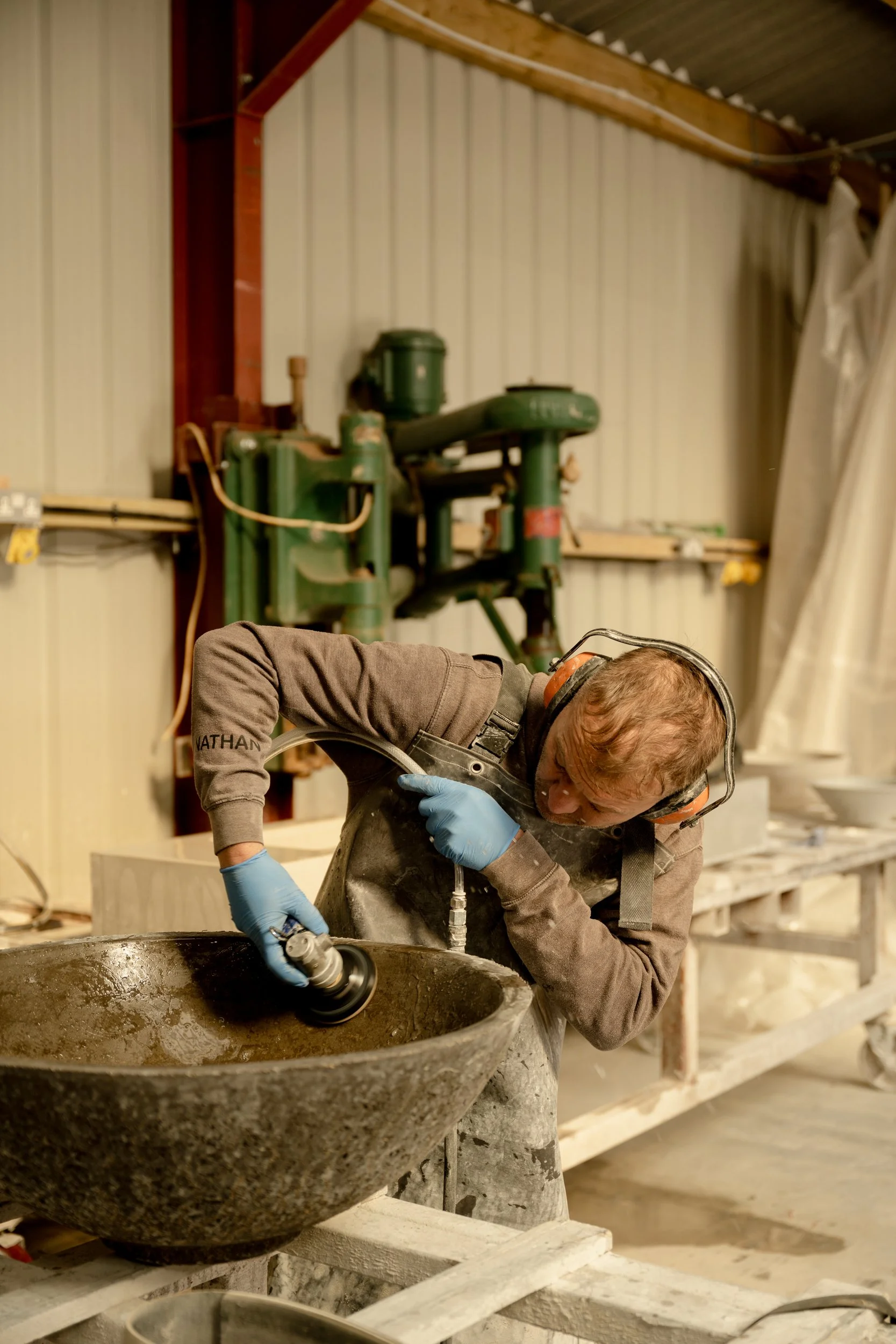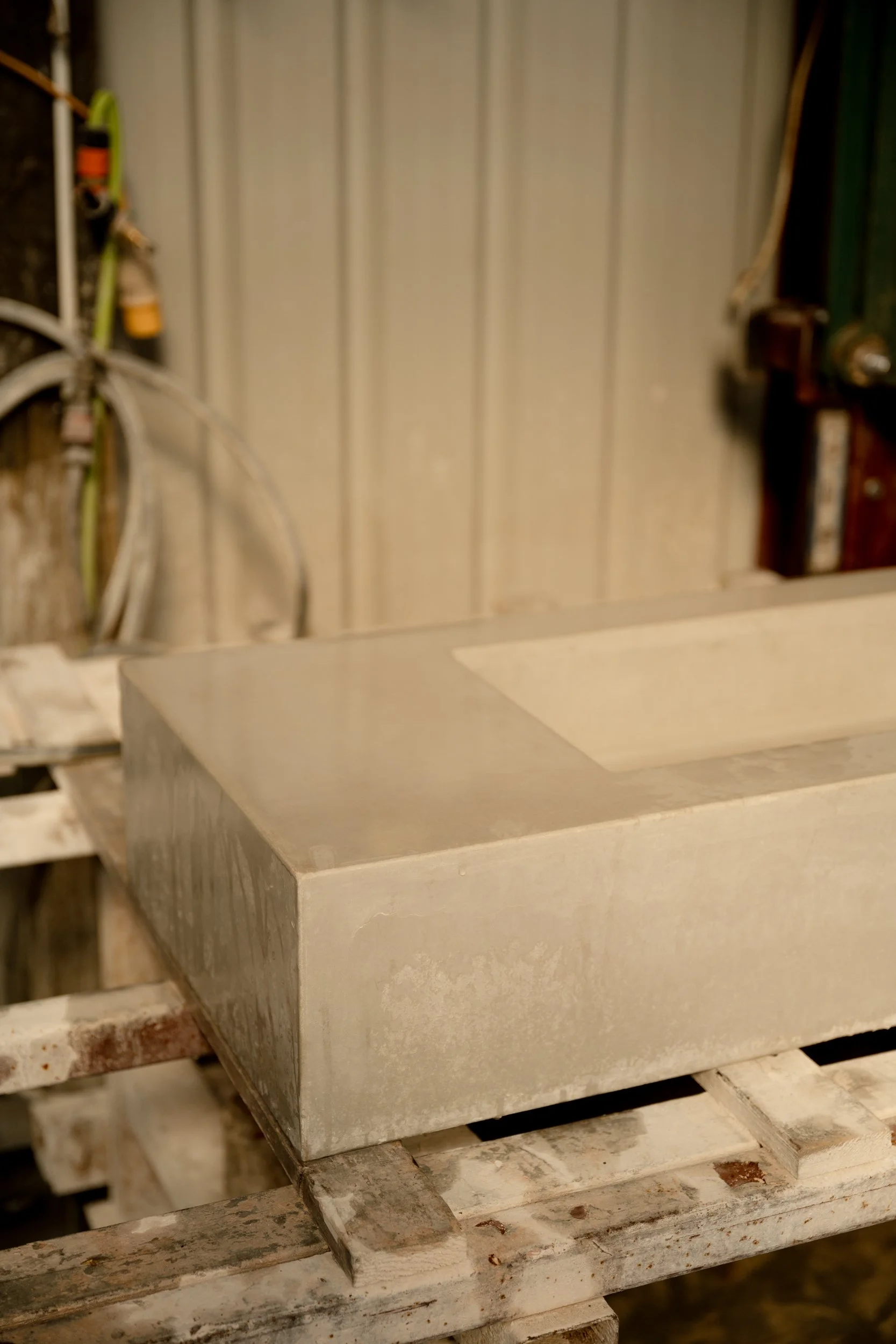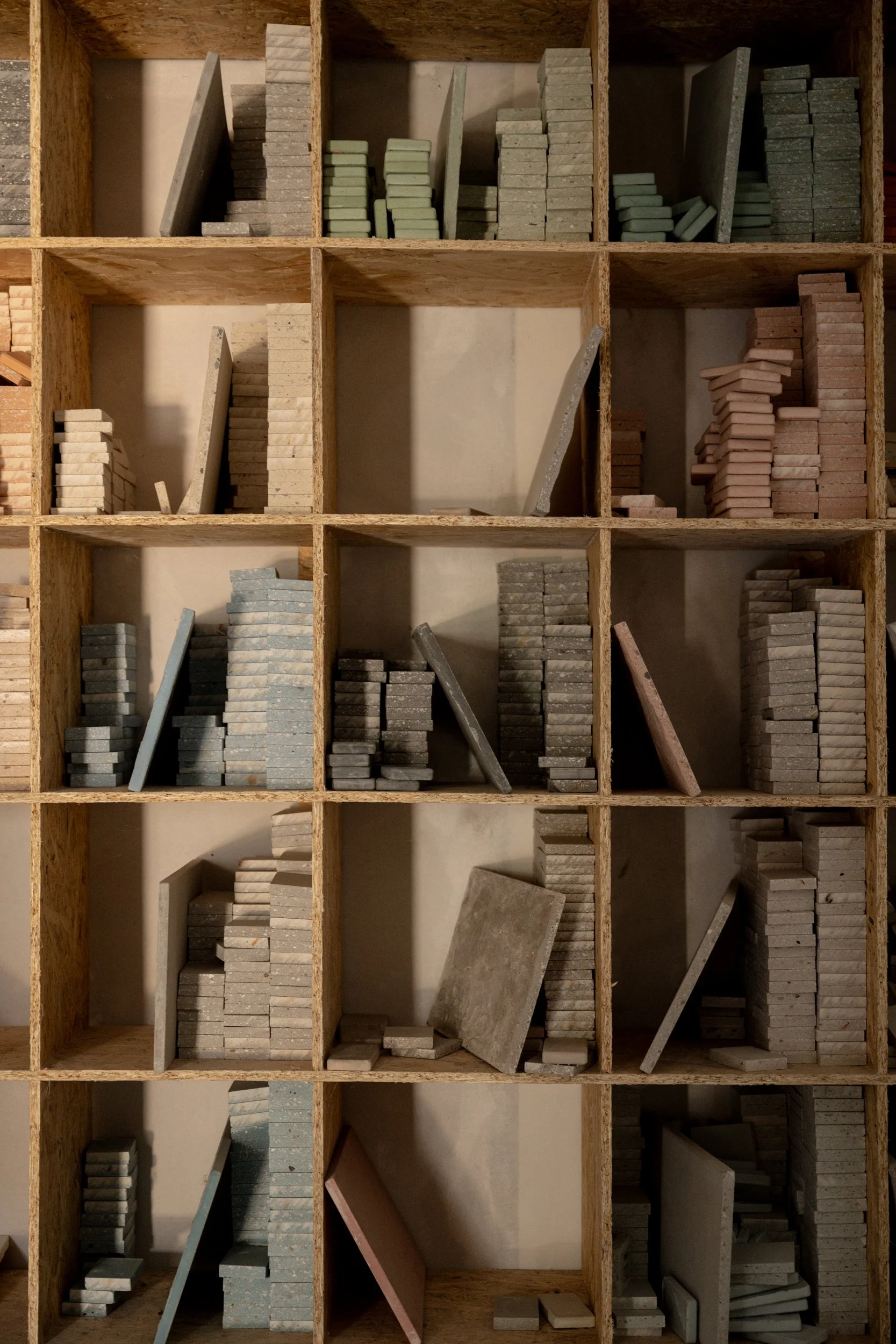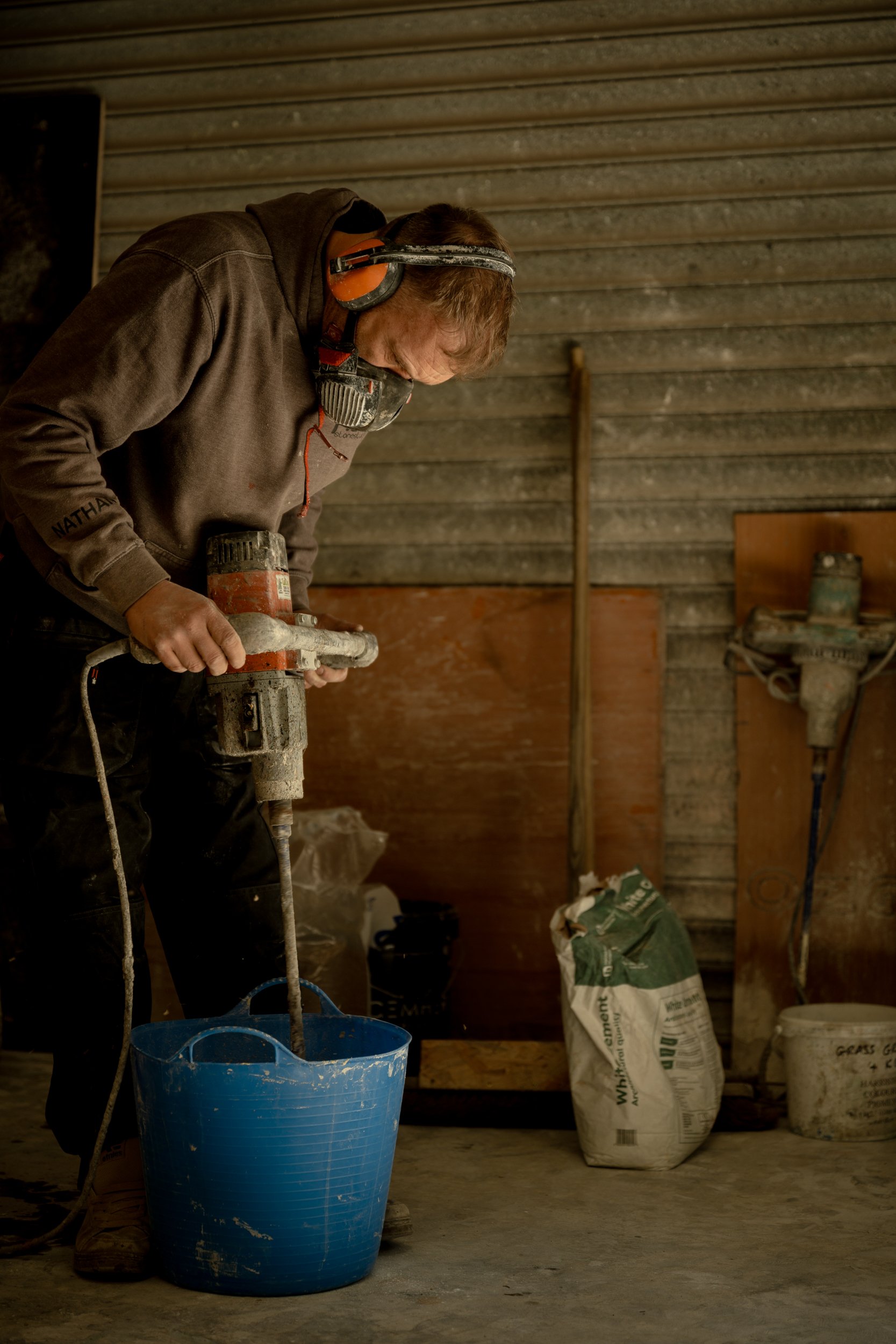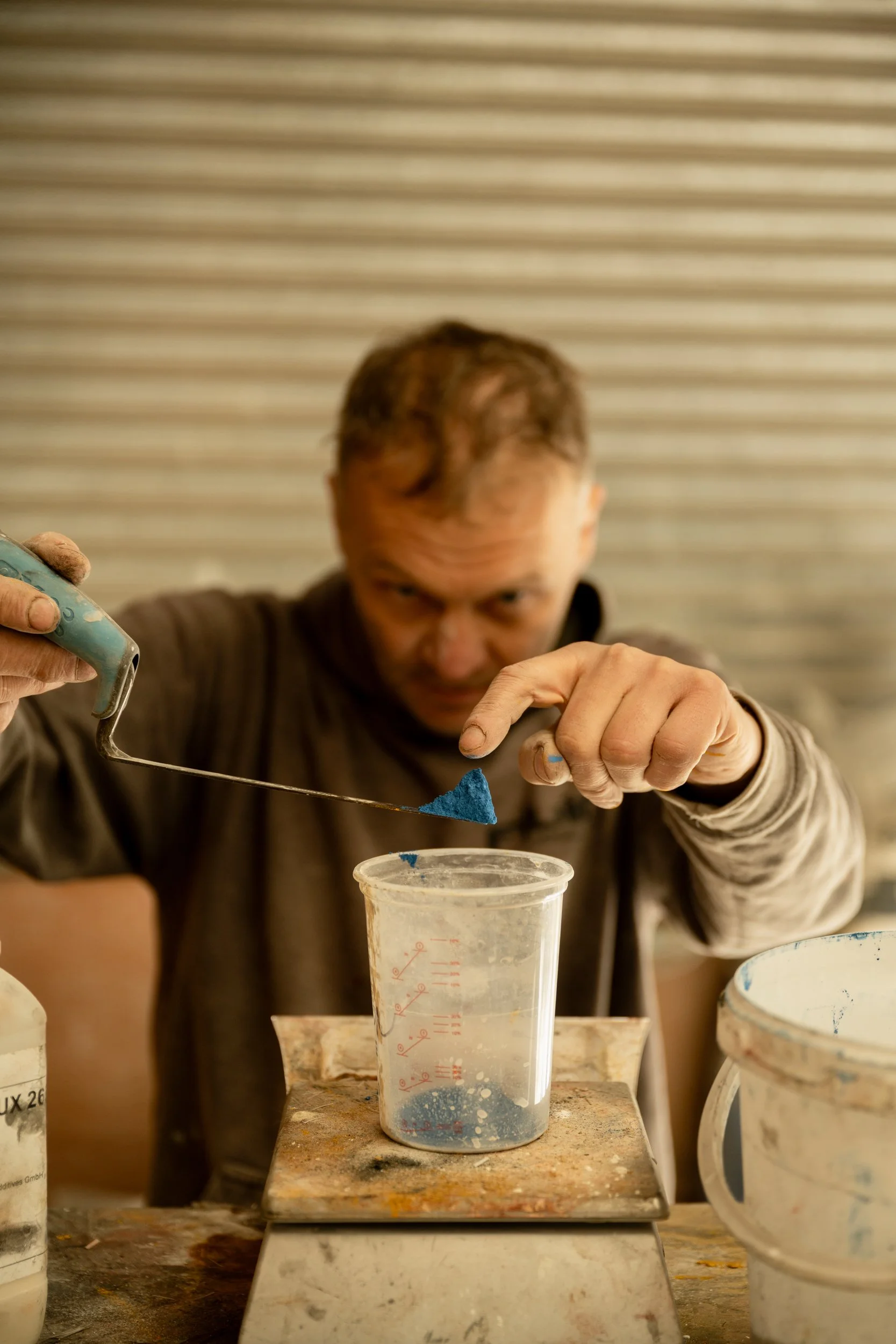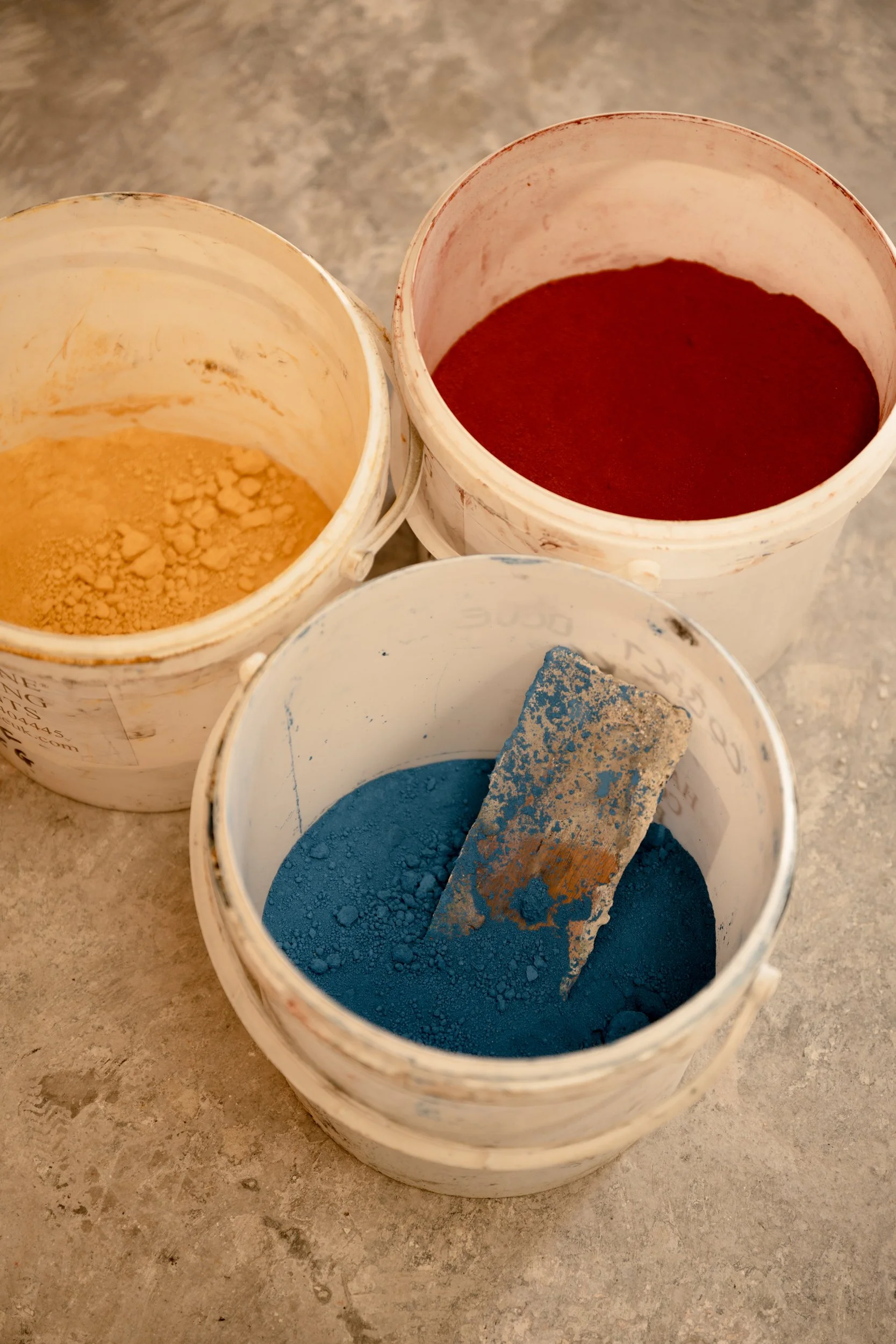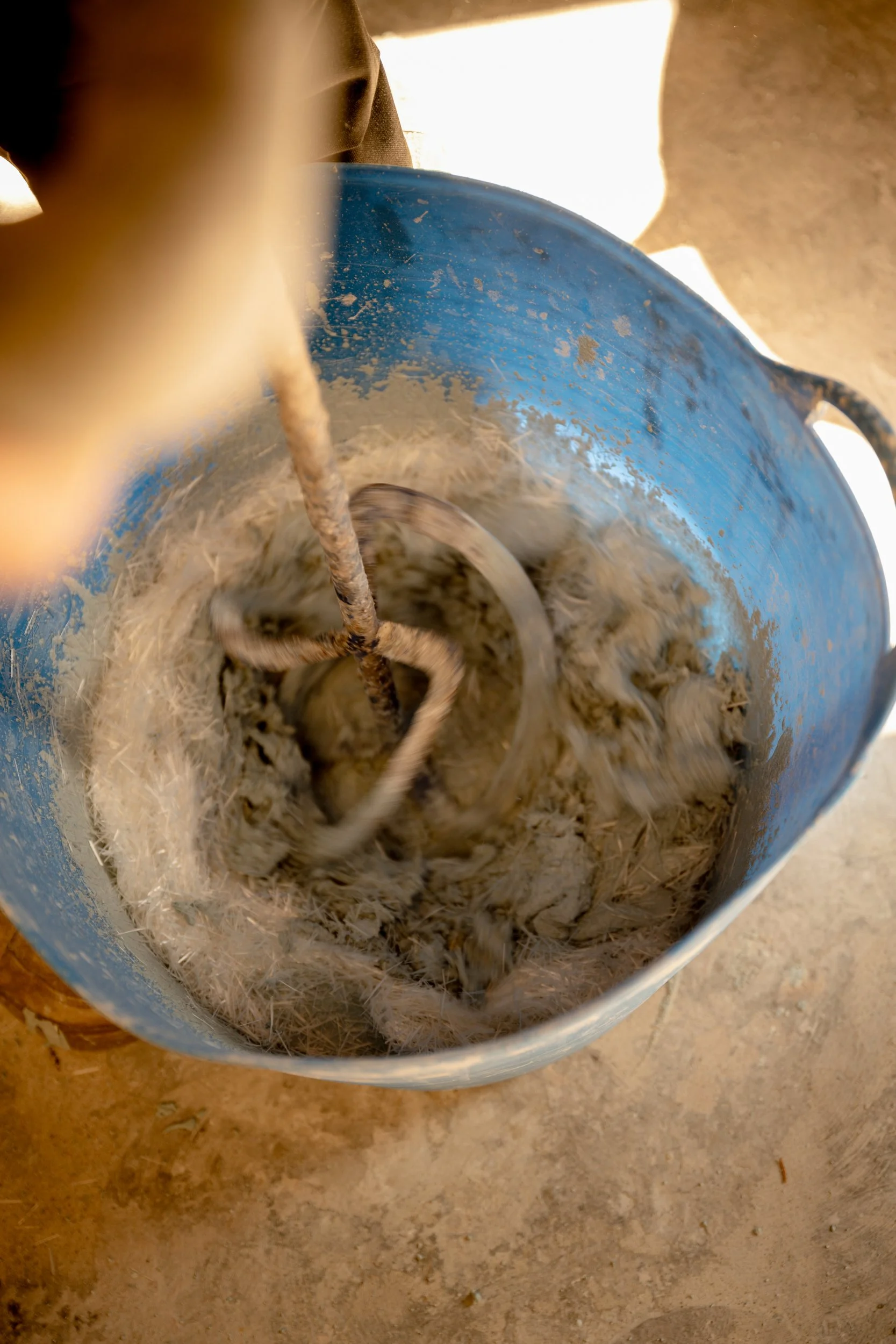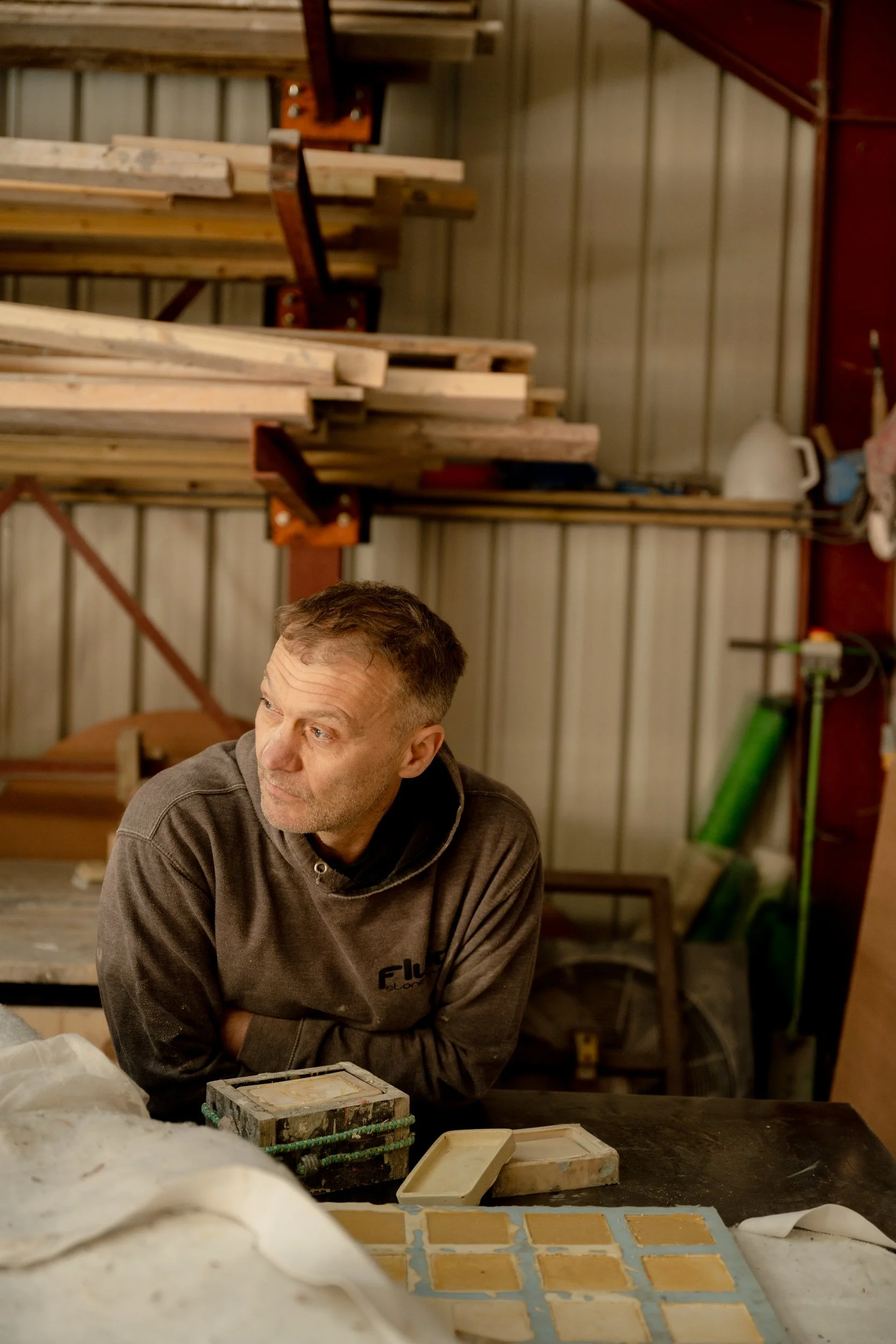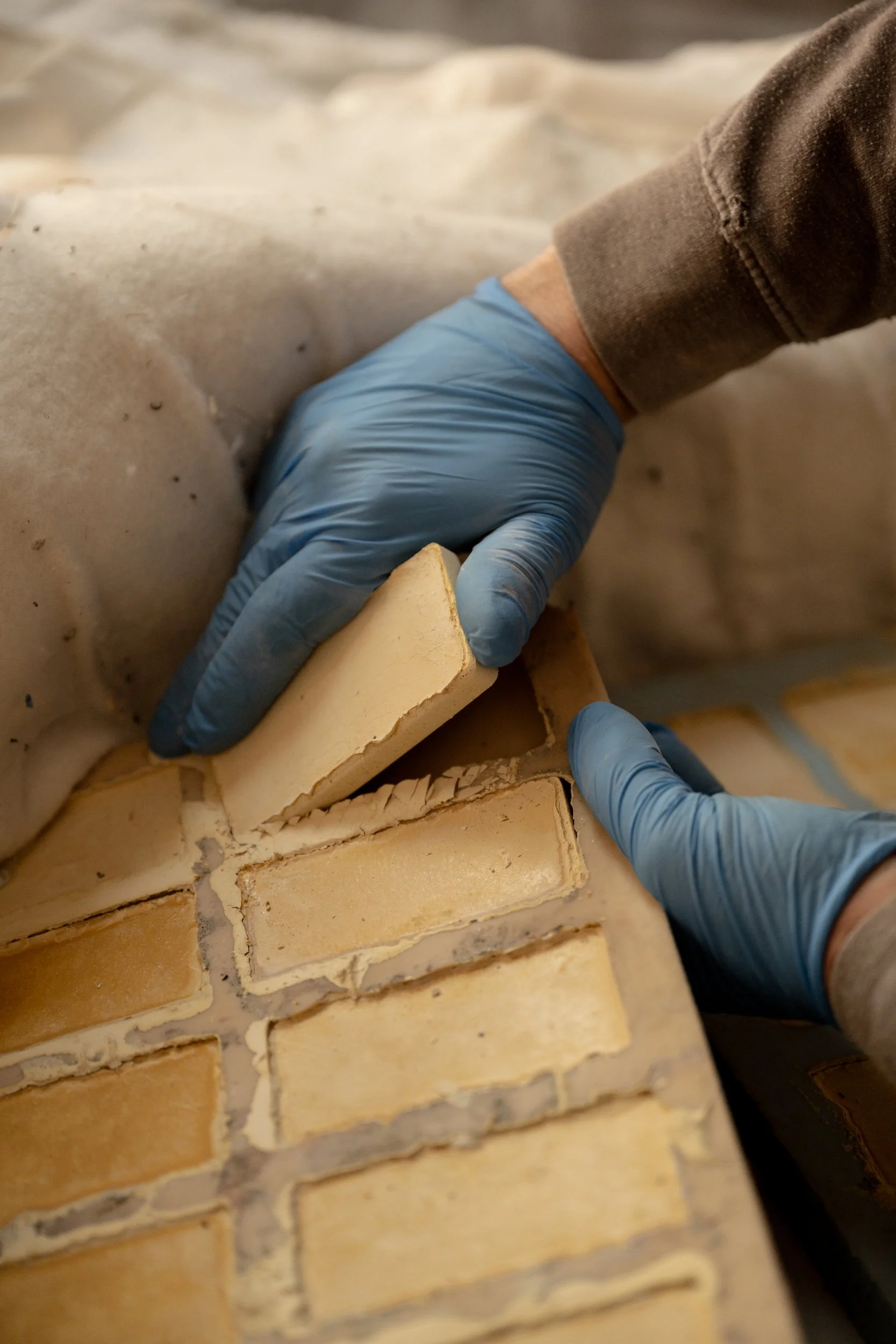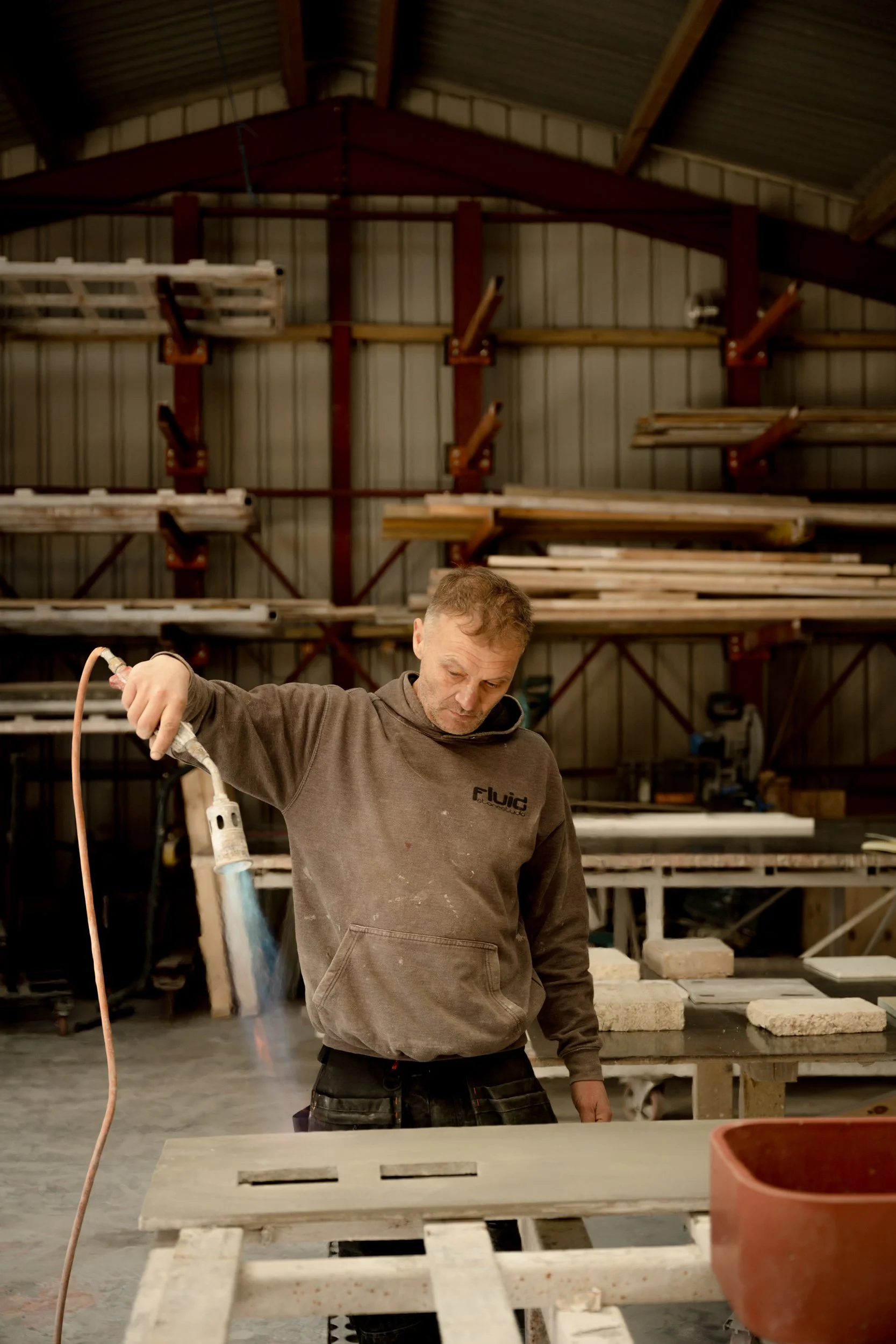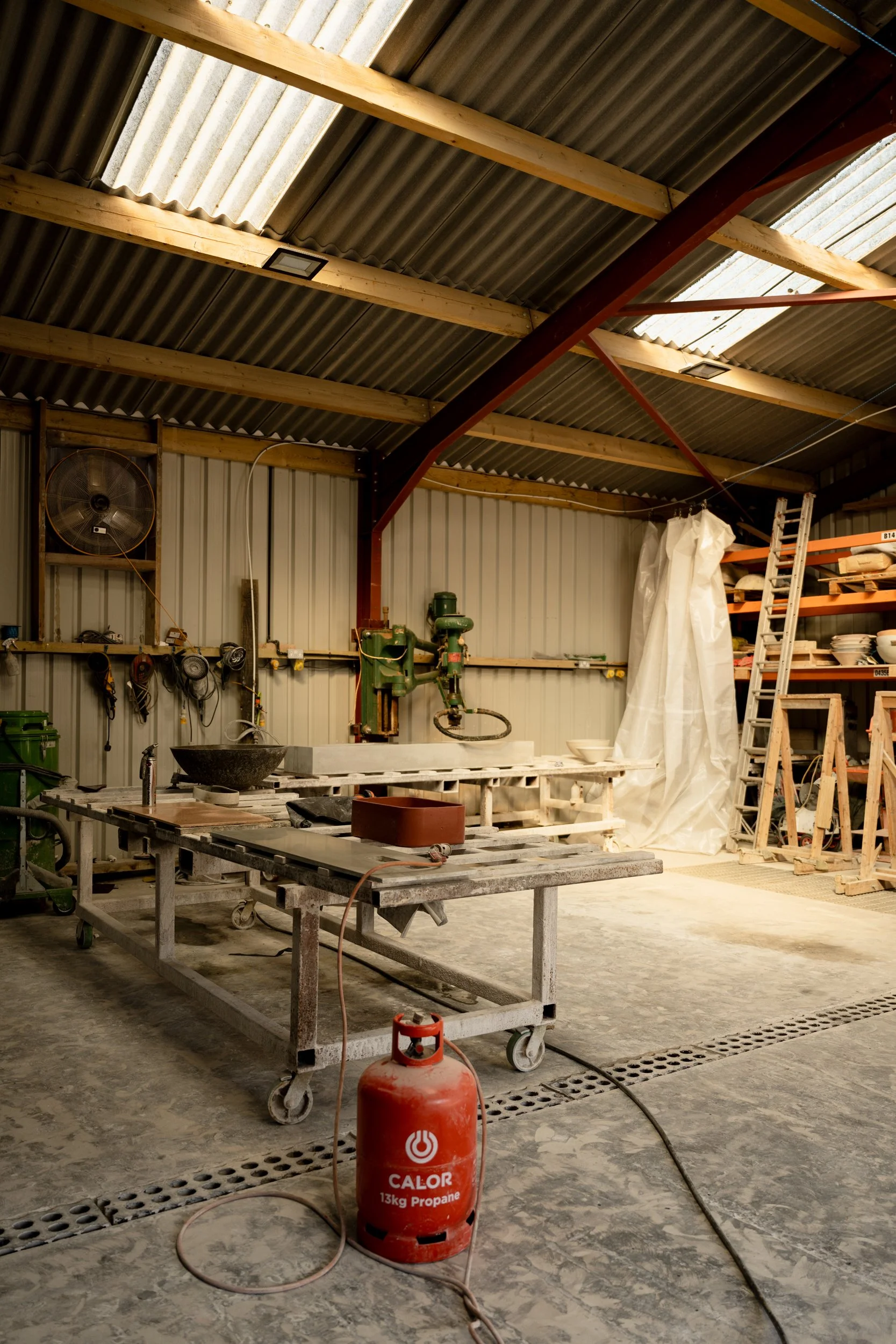Fluid Stone Studio
The Alchemy of concrete
The road to Nathan’s workshop on the north coast of Wales is bathed in golden spring light. A soft breeze rolls in from the sea, which peeks through the trees just beyond the building—only a short walk away. As we step inside, Nathan greets us with a firm handshake, his hands rough with the telltale signs of hard work, still dusted with concrete. With a wide grin, he chuckles, “As a kid, I loved making mud pies—just getting covered in dirt. Now I work with posh mud and actually get paid for it.”
Nathan leads us through the space, an old car repair shop with history in its bones. “It had seen better days,” he says in his signature soft, melodic Welsh lilt. “So I bought it and ended up ‘repairing’ the whole place—by replacing everything.” What was once crumbling has been transformed into an inspiring haven for craft, where the rawness of concrete meets the refinement of vision.
"I grew up in this village," Nathan says. "My granddad worked in the local quarry, and my dad hauled concrete for it. As kids, my friends and I would spend hours up there—climbing on heavy machinery, sliding down slag heaps of crushed granite, coming home covered in dust. Looking back, not much has changed. I guess it was only a matter of time before I found my own way of shaping stone. It’s in the family, in the landscape… in me.”
His path, however, wasn’t a straight one. University took him into sound and video technology—another form of creation, he muses. “I dabbled in video editing, did some music for television, but it didn’t quite stick. Then, like you do... I decided to try carpentry.”
Woodwork had always fascinated him. “I loved it at school—just making things. I remember crafting a wooden clock, cutting out all the cogs on a bandsaw, piecing them together. It was just... fun.” That love led him into shopfitting, house building, and eventually, concrete.
“As a carpenter, you work with concrete too—civil engineering-type stuff. But then I saw people in America using it for decorative purposes, in kitchens and furniture. I thought, ‘That’s cool.’ I started experimenting, got obsessed, and just kept going.”
By 2008, he committed to it full-time. “The first year was all about learning, building a website, doing projects for free—just getting my hands dirty, literally. Jobs came slowly at first, maybe one or two a year. But concrete was still a niche back then. Over time, it grew. Three years in, things started taking off.”
Interior design had always felt like foreign territory. “If you show me something, I can tell you if I like it or not,” she laughed. “But I can’t do anything with a blank piece of paper. I’m an accountant. Creativity is not our strong suit!”
She said it with a self-deprecating grin, the kind people use when they’ve spent years excelling in one world, only to find themselves humbled by another. But Heather knew numbers. She knew value. And she knew what it felt like to walk into a space and finally feel at ease.
She started scrolling through renovation posts, half-looking, half-dreaming, when a comment stopped her. A woman spoke of a designer - clean lines, nothing loud, nothing wasted. Stylish but quiet. It sounded right. “I didn’t want ultra-luxury. Just something solid. Something that worked.”
The words stayed with her. Testimonies about budgets kept, homes that felt lived-in and loved. That sealed it. She reached out to Lisa at Malt Interiors.
Lisa’s New York roots, paired with twenty years in the UK, struck the perfect balance. American efficiency with an understanding of British design nuances. They clicked instantly. Now, three years later, Heather couldn’t be happier.
“Small things made the biggest difference,” Heather said. “The pantry, the wine fridge. Moving the washer-dryer. Gave me space I didn’t know I was missing.”
They were quiet changes. The kind of changes that don’t just fill a room - they make it work. She moved through the kitchen now with ease, cooking often. A friend had given her a cookbook, filled with recipes shaped just for her. The Caesar salad - simple, sharp - was the one she returned to again and again.
“It feels like me now,” she tells Lisa when they speak.. Not just a kitchen. A home. Something she’d wanted for a long time. And in building it, she found more than space and light - she found a friend. One who listened. It’s been a win in every sense of the word.
The home she built here isn’t just well-designed. It’s a reflection of that long journey. A place where all the cities, all the years, all the work finally found rest. Where she could brew her coffee, feel the morning light on her face, and know she had arrived.
Concrete waits for no one, and Nathan knows it. He moves with purpose, fully immersed in the rhythm of his craft. There’s a steady hum of activity in the workshop—the whir of polishing pads smoothing down the surface of several pieces, each destined for a different space, a different story. In the middle of the workshop, a large slab demands his attention. With practiced ease, he fires up a massive blowtorch, its blue flame roaring to life as he seals the surface. The heat dances across the concrete, locking in its texture. It’s a process that requires both precision and instinct. But Nathan doesn’t hesitate. He works fast, steady, in sync with the material—because concrete, once set in motion, doesn’t stop for anyone.
His curiosity is restless, always pulling him toward something new. “Lately, I’ve been watching glassmakers, thinking about cutting glass and embedding it in my pieces. There’s this guy who makes his own glass, polishes it into these stunning art pieces. I might try something like that with my new saw over there. But honestly? I don’t think I have any goals left—I feel like I’ve already done everything.”
Inspiration strikes him in unusual places. “I love going to art galleries and museums—not just for the art, but for the buildings themselves. I spend more time admiring the walls, the materials, the structure. There’s a little gallery in the next town with these incredible concrete walls—absolutely fab. Even when I go shopping with my wife, I’m more interested in the shopfitting than the clothes, running my hands over surfaces, figuring out how things are made.”
Nathan’s world is a constant churn of ideas, unfinished projects, and the thrill of making—whether it’s speakers, custom furniture, or the next big thing that wakes him up in the middle of the night. And somehow, that unfinished energy is exactly what keeps it all moving forward.
Though he no longer lives in the village, he’s found a rhythm that works. “I try not to work weekends—most of the time, I don’t. I start late, finish late, but I get to take the kids to school, which is nice. I can lose hours in the workshop, tinkering, getting stuck into something, and suddenly it’s six or seven in the evening. But that’s not late, right? Well, maybe not by London standards,” he laughs.
Experimentation is at the heart of Nathan’s work. “I love trying new designs, but let’s be honest—there’s a reason the workshop floor is so level. I filled the old car repair pit with about £100,000 worth of mistakes. They had to go somewhere, so I used them as hardcore. You’ve just got to make mistakes, learn, and do it all again.”
Collaboration is another key to his work. “Working with Lisa at Malt Interiors is brilliant—everything is planned, no last-minute panic. I’ve had clients call and ask for samples by the afternoon, not realising we live in Wales, where the post office isn’t even open half the time. With Lisa, everything is organised in advance—no sudden changes, no mishaps. Just smooth, streamlined work.”
“I’m good at figuring things out—taking a client’s vision and working out how to make it. People send reference photos and say, ‘Can you do this, but in this shape or that colour?’ It’s about managing the brief, understanding the form, and then making it happen—especially when it all has to end up in London, where most of my clients are.”
“Moving massive slabs makes you design things that don’t exist yet as heavy materials demand inventive solutions”. The granite industry has trolleys built for standard sizes, but with concrete, I can make something as big as I want in one piece. That meant designing my own trolleys to flip and transport them.” “Concrete isn’t just about weight—it’s about possibility”.
As our visit comes to an end, the long five-hour drive back to London looms ahead. But before we go, there’s time for one last moment of curiosity. We sift through colour samples—deep cobalt blues and newly crafted tiles—while Nathan gets to work on a sink bowl.
"Touch it," he says, gesturing to the freshly cast piece. It’s firmer than expected, yet there’s a slight give under pressure, the concrete shifting just enough to remind us it’s still in transition. Another creation, another experiment taking shape in his workshop.
As we say our goodbyes, Nathan stands in the heart of his space, surrounded by his work, it’s clear—this isn’t just a job. It’s the craft he was always meant to do.

